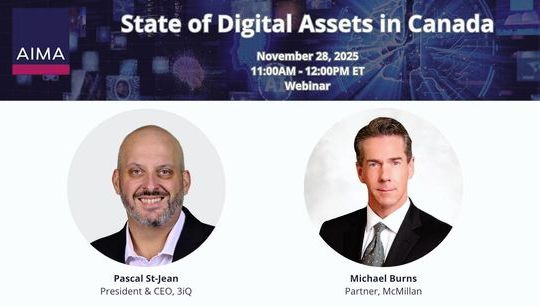Five issues for traditional hedge fund managers to consider when investing in digital assets. An update
By Sarah Crabb, Simmons & Simmons
Published: 21 March 2022
Traditional hedge fund managers (HFMs) continue to show interest in digital assets – we estimate at least half of the ten largest London based HFMs are now either investing in digital assets or actively considering doing so.
Simmons & Simmons partner, Sarah Crabb advises managers on specific points to consider for hedge funds seeking to include digital assets in their investment universe. Given the pace of developments in this area, and with input from Martin Shah (tax) and Paul Metcalfe (derivatives), she has updated her top five issues - HFMs seeking exposure to this asset class should consider.
1. Investment mandate
Generally, investment objective language (which is, typically, fairly broad) will not require amendment to incorporate digital assets. An addition, though, is usually recommended for investment strategy language.
Some HFMs take the view that investment of less than 1–2% of a fund’s portfolio in digital assets is not a material investment so there is no need to update relevant disclosures in the fund documentation (particularly where exposure is obtained via investment in derivatives and the use of derivatives generally is included). In our view, the better approach is to expressly include digital assets and/or digital asset derivatives in the offering document.
Specific risk factors should be incorporated for funds investing in digital assets (directly and via digital assets derivatives), disclosing the particular risks of investments in digital assets (including custody risks and tax uncertainties examined below).
2. Custody and depositary services
Managers typically appoint new custodians in respect of digital assets. The nature of how digital assets are held – ‘hot’ and ‘cold storage’ and use of the private key to move digital assets between wallets – requires a specialist custody provider with expertise and relationships with major digital asset exchanges. As the space evolves, several alternative custody solutions are now available, with key players located in the US and UK. Differences (some substantive) between the regulatory regimes for holding assets in those jurisdictions will influence the choice and location of the custody provider.
For funds managed by a UK AIFM and marketed into the UK, analysis is needed whether any digital assets must be held in custody, or their ownership verified, depending on the types of assets held and their regulatory classification. Options when finding a depositary-lite service provider to undertake these services for digital assets – especially those more difficult to categorise, such as stablecoins and security tokens – are currently limited.
UK AIFMs should also remember to submit a material change notification to the UK’s FCA if changing or appointing additional service providers to carry out depositary functions.
3. Exchanges
Unlike traditional asset classes, there is no central marketplace for exchanging digital assets – available exchanges vary in quality, some are relatively new, many are unregulated with no listing rules. This may carry greater risk of hacking and failure than an established, regulated exchange with greater regulatory oversight, controls and policies.
More participants in the exchange-traded derivatives space are expanding their offering to provide funds with greater access to trading digital assets. An exchange’s location and nature of the products traded can materially affect regulatory obligations (e.g. whether mandatory reporting regimes apply under EMIR or its UK equivalent). From a commercial perspective, managers are seemingly finding it harder to achieve their usual terms when trading exchange derivatives where the underlier is a digital asset, reflecting the greater volatility and increased risk perhaps associated with such strategies.
With this in mind, HFMs should undertake appropriate due diligence (DD) on any digital asset exchanges to be used – for instance, requesting information about the relevant exchange’s anti-money laundering (AML) policies, procedures, sanctions controls and ownership structure.
4. AML
A number of HFMs have sought exposure to decentralised finance (DeFi).
This approach is viable from an AML perspective where the fund buys tokens in a primary sale by a DeFi protocol or trades DeFi tokens through a centralised venue which does full KYC on participants.
However, where the fund uses a DeFi protocol that does not conduct checks on users, the situation is more problematic.
Although money laundering regulations do not oblige a HFM to do DD on counterparties, it must mitigate the risk of exposure to financial crime and FCA rules may require it to have systems and controls in place to do that. This typically includes understanding who the HFM is dealing with and, practically speaking, it is unlikely for the HFM to be able to undertake DD on users if the DeFi protocol does not.
5. Tax
The tax position when investing in digital assets remains crucial.
(a) Investment Manager Exemption (IME)
Almost all HFMs operating in the UK make use of the IME, which ensures that the trading profits generated by the UK investment management entity are not liable to UK tax.
The IME is only relevant if the manager is trading for UK purposes and applies in respect of certain specified investment transactions. Since spot trading in digital assets does not (yet) clearly fit within the types of investment transactions that are specified for these purposes, it remains unclear whether the IME will apply to UK HFMs in respect of profits arising from investments in spot digital assets, where the fund’s strategy is trading.
We hope to see movement towards bringing certain digital assets within the IME’s scope in the not too distant future. However, nothing is yet settled - all depends on HMRC’s stance in due course. We continue to ‘watch this space’.
(This is not an issue for funds that invest in digital assets via derivatives - such transactions already fall within the IME.)
(b) Yield farming
HMRC’s February 2022 guidance on yield farming adopts a potentially more aggressive line than other jurisdictions on taxation of DeFi transactions.
Previous guidance focussed on taxing returns from yield farming as trading or miscellaneous income. The new guidance:
- suggests that staking and unstaking crypto assets (and similar DeFi transactions) may constitute disposal and reacquisition for chargeable gains purposes if involving transfers of beneficial ownership
- states that the specific stock lending and repos tax regime, which provides for no disposal and reacquisition in similar circumstances, is not expected to apply to cryptocurrencies and
- could significantly increase tax compliance and costs for investors in digital assets.
Final word
Despite their increasing acceptance as a hedge fund investment, a number of points remain to be considered when embarking on diversification into digital assets.









